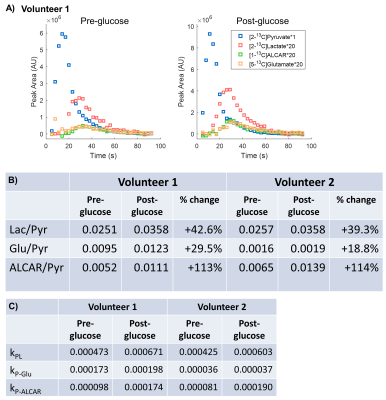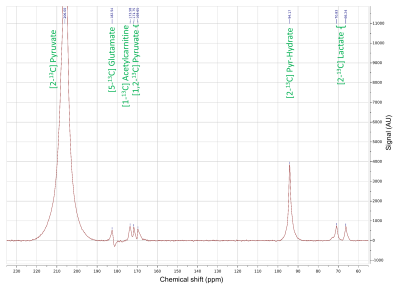Hsin-Yu Chen1, Jeremy W. Gordon1, Nicholas Dwork1, Brian T. Chung1, Andrew Riselli2, Robert A. Bok1, James B. Slater1, M. Roselle Abraham3, Daniel B. Vigneron1, and Peder E.Z. Larson1
1Radiology and Biomedical Imaging, University of California, San Francisco, San Francisco, CA, United States, 2School of Pharmacy, University of California, San Francisco, San Francisco, CA, United States, 3Department of Medicine-Cardiology, University of California, San Francisco, San Francisco, CA, United States
1Radiology and Biomedical Imaging, University of California, San Francisco, San Francisco, CA, United States, 2School of Pharmacy, University of California, San Francisco, San Francisco, CA, United States, 3Department of Medicine-Cardiology, University of California, San Francisco, San Francisco, CA, United States
It is safe and feasible to visualize real-time myocardial Krebs cycle energetics in human heart using hyperpolarized [2-13C]pyruvate MR spectroscopy. The metabolic products [2-13C]lactate, [5-13C]glutamate, and [1-13C]acetylcarnitine increased in response to oral glucose challenge.

Figure
4. A)
Temporal evolution of the injected [2-13C]pyruvate
and downstream metabolites [2-13C]lactate, [5-13C]glutamate and [1-13C]acetylcarnitine(ALCAR)
in Volunteer 1 before and 30-minutes after oral glucose challenge. Time was
calculated from the start of injection. B) A
table showing the metabolites ratios normalized to pyruvate. The levels of
lactate, glutamate and ALCAR were elevated after oral glucose compared to
baseline.
C) Rate
constants of pyruvate-to-product conversion were calculated to a first-order
approximation.

Figure
2.
Representative summed spectra (Volunteer 1) reflecting baseline Krebs cycle
energetics in human heart probed with hyperpolarized C2 pyruvate. The
substrates and products in the spectra were assigned [5-13C]glutamate(182.5ppm), [1-13C]acetylcarnitine(ALCAR,
173.6ppm), [2-13C]lactate(70.8, 66.2ppm), [1,2-13C]pyruvate(171.8, 169.7ppm), and
[2-13C]hydrate(94.2ppm), respectively.
